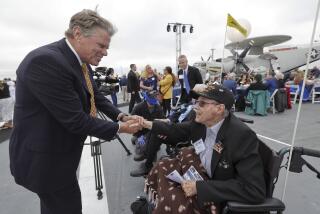Richard Cormier; War Hero, Blue Angels Leader
- Share via
Richard “Zeke” Cormier, fighter ace and war hero who led the Blue Angels and helped guide the world-famous San Diego Aerospace Museum, has died at the age of 81.
Cormier died Feb. 23 of cancer at his home in Rancho Santa Fe near San Diego.
In World War II, he shot down eight Japanese planes and probably two others, earning the double ace designation.
He flew 75 combat missions in the Atlantic from anti-submarine carriers and 61 missions in the Pacific, garnering five Distinguished Flying Crosses, the Silver Star and eight Air Medals.
“Zeke was a national hero. He did all the things that a naval aviator would want to do over a 23-year career,” Phil Wood told the San Diego Union-Tribune.
Cormier, Wood and astronaut Wally Schirra teamed to write the 1997 history of modern flying, “Wildcats to Tomcats: The Tailhook Navy.”
In the Navy from 1941 until 1964, Cormier had stints in Seoul during the Korean War and ended his military career as executive officer of the amphibious ship Wasp.
Adding to Cormier’s stature was his stellar work beginning in 1953 as flight leader of the Blue Angels, the Navy’s celebrated demonstration flying team. He directed the group’s transition from F9F-5 planes to the newer swept-wing Cougars. And in the single year of 1956, Cormier led the Blue Angels in 52 flight demonstrations before 3.5 million spectators.
Hollywood came calling, and Cormier served as technical advisor for the 1960 television series “Blue Angels” starring Dennis Cross and Morgan Jones and occasionally featuring Burt Reynolds. Although plotted around fictional off-duty escapades of the flying team, the series strove for realism by using footage of the Blue Angels and scenes at San Diego’s Miramar Naval Air Station.
Cormier happily turned his hero status to work for the community, first as founding president of the International Aerospace Hall of Fame. When that became a part of the San Diego Aerospace Museum in 1963, he joined the board and worked to develop the museum for the next 28 years.
In 1980, Cormier served as acting executive director of the museum. He ended his board service as president in 1990.
He helped promote such programs as “Flight of the Lone Eagle,” the museum’s 1997 exhibit honoring the 70th anniversary of Charles Lindbergh’s historic solo flight from New York to Paris.
“The Spirit of St. Louis was built in San Diego by San Diegans, and the world should remember that,” Cormier told The Times then. He pointed out that workers at what was Ryan Airlines built Lindbergh’s plane in their factory, a converted cannery, in 60 days for only $10,580.
Born in Washington state and reared in San Diego, Cormier attended San Diego State College for three years before joining the Navy. After his retirement in 1964, he worked 10 years for Douglas Aircraft, handling international military sales.
He is survived by his wife, Kitty; two daughters, Adrienne Walker and Maureen Ewell; two sons, Kevin and Stephen, and 10 grandchildren.
Military graveside services are scheduled for 1:30 p.m. today at Fort Rosecrans National Cemetery.
The family has asked that any memorial donations be made to the Tailhook Education Foundation, San Diego Hospice or the San Diego Aerospace Museum.
More to Read
Inside the business of entertainment
The Wide Shot brings you news, analysis and insights on everything from streaming wars to production — and what it all means for the future.
You may occasionally receive promotional content from the Los Angeles Times.










